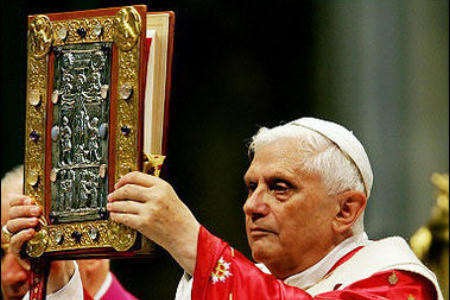The Shape of the New Testament
One of the wonderful treasures of the Catholic faith in the Roman Rite is the Lectionary.

Every Sunday the congregation hears large chunks of Scripture selected from different parts of the Bible, from both the Old and New Testaments:
1. Old Testament passage
2. Psalm
3. New Testament Epistle
4. Gospel Reading
Making Connections
The Readings selected for each week are usually united by a common theme. This is especially true for the Old Testament passage and the Gospel Reading. The brilliance of this arrangement is that it shows the unity between the Old and New Testaments. As the great Early Church Father, St. Augustine, wrote:
“The New Testament is hidden in the Old and the Old is revealed in the New”
– St. Augustine of Hippo, “Quaestiones in Heptateuchum” 2.73
However, as good as this arrangement is, I have found that it can lead to certain difficulties. In particular, Catholics can sometimes have difficulties understanding how the Readings they hear on Sunday relate to the respective books of Scripture from which they are drawn, and also how those books fit into the the New Testament as a whole.
What can be done to address this problem? Well, when leading small Bible study groups, I always begin by asking those present to walk me through their New Testament’s “Table of Contents” page. I do this because, as with most things, once one comprehends the overall structure of something, the contents becomes less intimidating and more memorable because one already understands the framework and context in which that content has been placed.
New Testament Structure
Below is a rough outline of the structure of the New Testament:
1. Gospels (4 Books)
The New Testament begins with the Gospel books. The word “Gospel” is the literary genre of these books and means “good news”. These books appear at the beginning of the New Testament because they contain the teaching, life, death and resurrection of the Lord Jesus and therefore hold pride of place in the New Testament. They are arranged in the order of composition as believed by Early Church Fathers such as Papias and St. Ireneaus.
The Gospels may be subdivided into two groups:
(a) Synoptic Gospels (3 Books)
These Gospels are grouped together because of their similarity in style and content.
- Matthew (The Apostle)
- Mark (A companion of Paul and later Peter)
- Luke (A companion of Paul)
(b) Fourth Gospel (1 Book)
The last Gospel is noticeably different in style and content from the first three.
- John (The Apostle)
2. History (1 Book)
After the Gospels appears a history book…
- The Acts of the Apostles
Acts was written by St. Luke and is effectively the sequel to his Gospel. It picks up the story after Jesus’ Ascension, describing the life of the Church between approximately AD 30-60.
3. The Letters (20 Books)
The bulk of the New Testament consists of the letters which were sent in the Apostolic Church to address the various issues being faced by the emerging communities of Christians.
(a) Letters of Paul (13 Books)
The majority of the letters come from St. Paul. His letters are not arranged chronologically, but are instead divided into three groups:
I. Letters to groups (9 Books)
Paul’s letters to cities and areas appear first. They are arranged roughly in order of length, from the longest to the shortest:
- Romans (City of Rome)
- 1 & 2 Corinthians (City of Corinth)
- Galatians (The region of Galatia)
- Ephesians (City of Ephesus) Prison Epistle
- Philippians (City of Philippi) Prison Epistle
- Colossians (City of Colossae) Prison Epistle
- 1 & 2 Thessalonians (City of Thessalonica)
II. Letters to individuals (4 Books)
Paul’s letters addressed to individuals then follow, which can again be divided into two groups:
(i) Pastoral Epistles (3 Books):
These are letters full of pastoral advice written by Paul to his disciples and protégés:
- 1 & 2 Timothy
- Titus
(ii) Non-Pastoral Epistles (1 Book):
- Philemon Prison Epistle
III. Sermon (1 Book)
- Hebrews
Hebrews is not so much a letter, but rather a sermon, in which it explains Jesus in terms of the Old Covenant priesthood and sacrificial system. It appears at the end of the collection of Paul’s work (“Pauline Corpus”) because of the dispute in the Early Church as to whether or not Paul was its author.
(b) Catholic Epistles (7 Books)
These are the epistles written by other Church leaders. Unlike the Pauline epistles, the names of these epistles indicates the author, not the recipient. These letters are called the “Catholic Epistles” because of the broad range of their intended audiences.
- James
- 1 & 2 Peter
- 1 , 2 & 3 John
- Jude
4. The Apocalypse (1 Book)
- Book of Revelation
This is probably the last book of the New Testament to be authored. Revelation is an apocalyptic book and therefore is packed with rich symbolism. It is appropriately placed at the end of the New Testament since it concludes with a description of the end of time.
So that’s the structure of the New Testament. Tomorrow we’ll look at how this can apply this knowledge…
Jimmy Akin from Catholic Answers has just produced a post on this same topic:
http://jimmyakin.com/2012/07/why-is-the-new-testament-organized-this-way.html